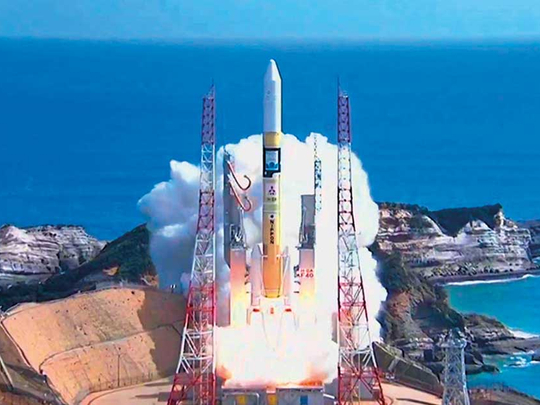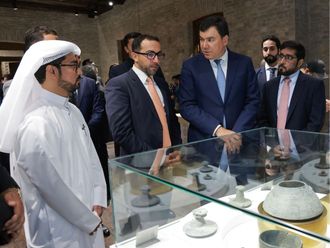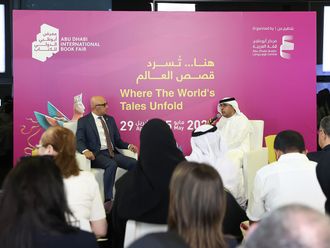
Dubai: History was made at 8.08am on Monday when the UAE’s KhalifaSat, the first All-Emirati made satellite, was successfully launched into space, paving the way for the realisation of the UAE’s space ambitions that extend beyond a century.
The KhalifaSat was launched at the Tanegashima Space Centre in Japan and entered into a low earth orbit at an altitude of approximately 613 kilometres at 9.33am, 85 minutes after its launch. The first signal was successfully received at the ground station at the Mohammad Bin Rashid Space Centre (MBRSC), which developed the satellite.
The successful launch marked a new milestone that adds to the UAE’s achievements and a new phase in the development of the national space sector.
Three teams from MBRSC were in Japan to oversee the launch while another team was at the ground station of MBRSC to receive the first signal from the satellite. The teams erupted in jubilation as soon as orbital insertion was confirmed, marking the success of the launch.
It was an emotional moment. Some members burst into tears as hugs and greetings were exchanged.
In Dubai, Shaikh Hamdan Bin Mohammad Bin Rashid Al Maktoum, Crown Prince of Dubai and Chairman of MBRSC, followed the first contact made by the satellite at the ground station at the space centre in Al Khawaneej. Shaikh Hamdan congratulated the UAE leadership for yet another milestone in securing a bright future for the nation. He also thanked MBRSC for its hard work.
Top officials namely Dr Ahmad Abdullah Belhoul Al Falasi, Minister of State for Higher Education and Advanced Skills and Chairman of the Board of Directors of the UAE Space Agency; Khalid Al Ameri, UAE Ambassador to Japan; Hamad Obaid Al Mansouri, Chairman of MBRSC; Yousuf Hamad Al Shaibani, Director-General of MBRSC; Dr Mohammad Nasser Al Ahbabi, Director-General of the UAE Space Agency; and Eng Salem Humaid Al Merri, Assistant Director-General for Scientific and Technical Affairs at MBRSC were in Japan to watch the launch.
Al Mansouri said launching this satellite during the Year of Zayed “emphasises the determination of Emiratis to achieve the vision of the late Shaikh Zayed Bin Sultan Al Nahyan, who believed that building a nation begins with investing in its people who are the foundation of any development and real progress”.
Al Shaibani, for his part, dedicated this new Emirati achievement to the UAE’s wise leadership who believes in the capabilities of young Emirati men and women.
“The leadership has provided them with all the necessary resources to design and build the first Emirati satellite at the MBRSC. KhalifaSat is another milestone in the UAE’s space journey and its programme to develop space technologies and sciences,” Al Shaibani said.
Amer Al Sayegh, KhalifaSat Project Manager at MBRSC, congratulated his team for their years of hard work that finally paid off on Monday.
“KhalifaSat has demonstrated that Emiratis are capable of enhancing the UAE’s position as a global hub for the space industry. I congratulate all the team members who have contributed to developing KhalifaSat and followed up on its successful launch,” Al Sayegh said.
1) What is KhalifaSat?
The KhalifaSat is an Earth Observation satellite that will orbit the Earth from pole to pole at a distance of 613km. The hexagonally designed satellite has two decks as well as an upper sun shield made of a carbon fibre reinforced polymer that protects the sensitive camera system from the extreme environment in space, specifically temperature fluctuations and radiation.
2) How does the KhalifaSat work?
The KhalifaSat works essentially like a specialised camera in space powered by the sun. To give you an idea, it’s like the Earth is taking high-resolution selfies continuously.
3) What makes KhalifaSat unique?
The KhalifaSat is unique from all the three other satellites developed by MBRSC because it was built from scratch on UAE soil by highly qualified Emirati engineers.
It bagged five patents and developed seven space innovations that have given the satellite an enhanced digital camera; fast image download and high-speed communication capabilities from its position anywhere above the world; an automatic satellite control system with increased storage capacity; a satellite positioning technique that allows it to simultaneously capture multiple 3D images; as well as advanced target positioning for capturing high quality images with pinpoint accuracy and high speed.
4) What will happen after the launch?
MBRSC has about a week to manage the satellite telemetries, a feature in the satellite that collects information about target objects that are far away and then sends it electronically to the station.
An orbit calibration will be done to fix or adjust some parameters of the sensors on the satellite to ensure that they are working accurately in space.
5) What’s the first image that will be taken by KhalifaSat?
The first official photo be taken by the KhalifaSat will be that of a “unique place” on earth that will be revealed later on.
6) What is KhalifaSat’s coverage?
The KhalifaSat has a global coverage, meaning, it can take images anywhere around the globe.
7) What will happen to the images taken by KhalifaSat?
The images are beamed back to the Ground Station at MBRSC in Dubai. The Ground Control team receives the images and processes them as per requirements of the clients, in this case, either by the UAE government or private sector clients.
8) What are the uses of KhalifaSat’s images?
The images will be used to monitor environmental changes and the impact of global warming, effectively manage urban planning, and support relief efforts during natural disasters.
— with inputs from Faisal Masudi, Staff Reporter
Comment:
KhalifaSat represents a leap in UAE global ranks
By Mohammed Jalal Alrayssi, Executive Director of the Emirates News Agency, WAM
ABU DHABI: In the Year of Zayed, the UAE's ranking has catapulted among the top ten powerful countries in the world. Today's successful launch of KhalifaSat, the UAE designed, developed and manufactured space satellite, is proof of the UAE's strong standing and international presence among nations.
The UAE's space industry endeavours also include eight other multi-purpose satellites placed into orbit by the UAE, with plans to launch 12 satellites by 2020, a significant milestone in the UAE's strategy to make the space industry one of the most dynamic and vital economic and investment sectors.
KhalifaSat's successful launch and the aforementioned accomplishments are not only indicative of the UAE's space industries advancement, but also mark a qualitative shift in its global power ranking.
The UAE's ability to embark on this project since 2013, and its ability to construct its first-ever satellite on the nation's soil, by young highly skilled Emirati engineers, aged between 27 and 28 years, embodies the leadership's commitment to involving our youth for the sake of the nation's future and its progress and development.
This, in turn, highlights the importance of the UAE's integrated development objectives, making the country a central hub for technological development, and advancement in sciences not only regionally, but also globally. Worth noting is the UAE's investing more than Dh22 billion to advance the space industry and research to assist across multiple sectors especially those of environmental and humanitarian concern.
Another important message behind the launch of KhalifaSat is that of the human element. Millions witnessed the live launch of KhalifaSat from Japan's Tanegashima Space Centre, reflecting the strong bonds of partnership between the UAE and nations across the world, with the aim to ensure safety, peace and security for humanity.
The launch of KhalifaSat is a true testament to the UAE's space industry strategy aspirations, but also reflective of the country's leadership and their drive to spread a message of tolerance while strengthening the UAE's status as a leading global player.












